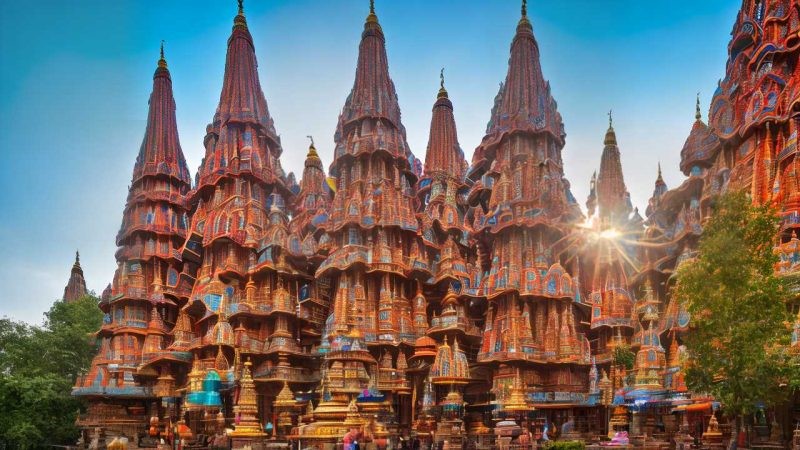The Core Value of Hindu Religious Writings

Hinduism is one of the oldest religions in the world, and its sacred texts, like the Vedas, Upanishads, and the Bhagavad Gita, are rich with teachings about life and spirituality. A key lesson from these texts is the importance of seeking truth and understanding our deep connection to everything around us. This idea isn’t just something to think about; it’s meant to be put into practice every day.
For example, the concept of Dharma is about doing the right thing and living ethically, while Karma teaches us that our actions have consequences. Moksha is the ultimate goal for many Hindus, which is about finding freedom from the cycle of rebirth and reaching a state of peace.
These ancient teachings are still very relevant today. They guide us on how to live a meaningful life and can help us find our purpose. The wisdom in these texts can show us how to deal with everyday challenges and remind us that our actions matter. They are not just old stories but practical advice that millions still follow.
When you read these texts, you can find practical advice that can help you understand life better. Whether you’re looking for ways to deal with stress or want to find a deeper meaning in life, Hindu scriptures can offer valuable insights.
Origins of Hindu Scriptures
Hindu scriptures, known as the texts of Sanātana Dharma, started in the ancient Indus Valley civilization. They’ve been written over thousands of years and show how people’s religious and philosophical ideas have changed over time. These writings cover a wide range of knowledge and traditions. For instance, the Rigveda contains deep religious songs, and the Upanishads are full of philosophical discussions. Many wise people, not just one author, wrote these texts over many years.
These scriptures are complex, with many levels of meaning and a lot of symbolism. To really understand them, you have to study them closely. They teach us about the divine, how to live a good life, and what reality is. This is why they are so important for Hindu beliefs and the way Hindus live their lives.
When reading these texts, you’ll find that they flow naturally and are written in a way that’s easy to understand, like a conversation. They are detailed and full of rich information, making them an essential part of Hindu culture.
Dharma: Eternal Duty
Dharma is a key idea in Hinduism. It’s about our duties, what’s right and wrong, and how to live well. It’s really important because it helps keep everything in the universe in balance. It’s more than just rules; it’s a way to grow spiritually, making sure our goals fit with what society needs and the rules of the universe.
Hindu teachings show that Dharma isn’t fixed; it can change depending on the situation. This flexibility keeps it relevant and helps people live good lives, which keeps Hindu society strong. It’s at the core of Hindu beliefs and everyday life.
Let’s make this clear: Dharma is like a guide that helps everyone in the Hindu community know how to act and live together peacefully. For example, it teaches that we should always tell the truth and care for others, which helps us all get along better. It’s an active part of Hindu life, shaping how people make choices every day.
Karma and Reincarnation
In Hinduism, karma is a key idea. It says that what we do, think, and plan will affect our future. We come back to life in a cycle called reincarnation, and that’s how karma shows its effects over our different lives. Hindu religious texts stress this a lot because it helps people make good choices.
Karma works like this: do good things, and you’ll be born into a better life next time. Do bad things, and you’ll face tougher situations. This cycle, called samsara, is all about making our souls better. It connects everyone and teaches us that we are where we are now because of what we’ve done before.
To make sure this is clear, let’s look at an example. If someone helps others without expecting anything back, they might be born into a life with a lot of happiness and opportunities. But if someone steals or hurts others, they could end up in a hard situation in their next life. This belief in karma and reincarnation encourages people to live well and take responsibility for their actions.
When we talk about karma, it’s important to remember that it’s not just about punishment and reward. It’s also about learning and growing as a person. Each life gives us a chance to do better than the last one. This is why so many people see karma as a path to becoming the best version of themselves. It’s a conversation we all have with ourselves, asking, ‘What can I do better next time?’
Moksha: Liberation Goal
In Hindu beliefs, understanding how actions lead to consequences and the cycle of life, death, and rebirth brings us to the most important goal: moksha. This is the idea of being free from the endless cycle of life. It’s not just a high-minded idea but something deeply important that influences how Hindus live and think.
Moksha means the soul gets free from the endless cycle of living over and over again. It happens when a person stops thinking just about themselves and understands that they are part of a bigger, timeless truth. This truth is linked to Brahman, which is the ultimate truth of the universe. Achieving moksha allows a person to get away from all the pain and problems of life.
To reach moksha, people often follow a strict spiritual path, live by strong moral principles, and work on growing their knowledge and love for the divine, while also learning not to be too attached to things. For example, someone might wake up early every day to meditate or choose to help others regularly as a way to practice these principles. By doing these things, they move closer to moksha.
Yoga: Pathways to Enlightenment
Yoga is more than just physical exercise; it’s a spiritual practice that can help people achieve enlightenment and find ultimate freedom, known as moksha. This practice has deep roots in old Hindu texts like the Bhagavad Gita and Patanjali’s Yoga Sutras. These sources don’t just talk about yoga as a way to stay fit; they describe it as a full system for cleaning up your mind and body, gaining deep spiritual understanding, and connecting your personal spirit (Atman) with the greater universal spirit (Brahman).
When you look closely, yoga offers different paths to enlightenment that fit different people’s needs and abilities. These paths are Karma (focused on doing good deeds), Bhakti (centered on love and devotion), Jnana (based on gaining knowledge), and Raja (which is all about meditation). Experts on the subject point out how flexible yoga is and how it can gradually help people understand themselves better. This idea of growing self-awareness is a key part of what Hindu philosophy is all about.
Let’s break down these paths a bit more. Karma Yoga, for example, encourages you to do good in the world without expecting anything in return. This helps you to become less self-centered and more compassionate. Bhakti Yoga uses prayer, worship, and chanting to build a deep connection with the divine. Jnana Yoga is for those who are driven by curiosity and intellect, urging them to study and learn as much as they can to understand the deeper truths of life. Finally, Raja Yoga is all about controlling your mind through meditation, helping you to stay focused and calm.
The beauty of yoga is that it’s not one-size-fits-all. You can choose a path that resonates with you, and that can make a big difference in how you understand yourself and the world around you. For those who are just starting out, it might be helpful to try a yoga class that includes a bit of everything, or perhaps begin a meditation practice with the help of an app or local group to kickstart your journey on the path of Raja Yoga.
Conclusion
Hindu sacred texts are important because they offer clear guidance on how to live a good life and find spiritual peace. These writings talk about key ideas like Dharma, which is doing one’s duty; Karma, which means our actions have effects; Reincarnation, the belief that our souls are reborn; and Moksha, the ultimate goal of being free from the cycle of birth and death. By following the teachings in these texts, people can live morally, understand themselves better, and aim to break free from endless rebirths.
This collection of writings is essential for understanding the universe and our place in it, helping Hindus find meaning and direction in life.
For example, consider the Bhagavad Gita, a part of the larger epic Mahabharata. It’s a conversation between Prince Arjuna and the god Krishna. In this dialogue, Krishna explains the importance of doing your duty without attachment to the results, which is a practical example of living by Dharma and Karma. This is just one of the many texts that offer insights into how to apply these core values in everyday life.
We strive to present the teachings of Ramana Maharshi and the traditions of Sanatana Dharma with respect and accuracy. Terms like "mythology" are used for ease of understanding and are not meant to diminish the significance of sacred texts.





